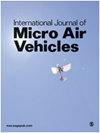KUBeetle-S:一种外形像昆虫、无尾、能够悬停的机器人,可以通过低扭矩控制机构飞行
IF 1.6
4区 工程技术
Q2 ENGINEERING, AEROSPACE
引用次数: 46
摘要
对于类昆虫无尾飞行机器人来说,扇动翅膀既要产生控制力,又要产生飞行力,使机器人保持在空中。这种能力需要一个主动控制机制,它应该与轻量级的微控制执行器集成,可以产生足够的控制扭矩来稳定机器人,因为它固有的不稳定性。在这项工作中,我们提出了一种集成在具有悬停能力的双翼扑翼16.4 g飞行机器人(KUBeetle-S)中的控制机制,该机制可以同时改变机翼冲程-平面和机翼扭曲。倾斜冲程平面会引起平均推力方向和机翼捻度分布的改变,从而产生俯仰和滚转的控制力矩。偏航(航向改变)时,左右翼根梁不对称调整,改变扑翼运动时机翼扭转,产生偏航力矩。通过使用三个同步高速摄像机测量机翼运动学,验证了机翼运动学的变化。然后,我们使用六轴力/扭矩称重传感器进行了一系列实验,以评估通过扭矩产生的控制机制的有效性。我们将控制机构与亚微伺服作为控制执行器和飞行控制板集成在一起,对机器人进行了原型设计。最后进行了自由飞行试验,以验证姿态控制的可能性。本文章由计算机程序翻译,如有差异,请以英文原文为准。
KUBeetle-S: An insect-like, tailless, hover-capable robot that can fly with a low-torque control mechanism
For an insect-like tailless flying robot, flapping wings should be able to produce control force as well as flight force to keep the robot staying airborne. This capability requires an active control mechanism, which should be integrated with lightweight microcontrol actuators that can produce sufficient control torques to stabilize the robot due to its inherent instability. In this work, we propose a control mechanism integrated in a hover-capable, two-winged, flapping-wing, 16.4 g flying robot (KUBeetle-S) that can simultaneously change the wing stroke-plane and wing twist. Tilting the stroke plane causes changes in the direction of average thrust and the wing twist distribution to produce control torques for pitch and roll. For yaw (heading change), root spars of left and right wings are adjusted asymmetrically to change the wing twist during flapping motion, resulting in yaw torque generation. Changes in wing kinematics were validated by measuring wing kinematics using three synchronized high-speed cameras. We then performed a series of experiments using a six-axis force/torque load cell to evaluate the effectiveness of the control mechanism via torque generation. We prototyped the robot by integrating the control mechanism with sub-micro servos as control actuators and flight control board. Free flight tests were finally conducted to verify the possibility of attitude control.
求助全文
通过发布文献求助,成功后即可免费获取论文全文。
去求助
来源期刊

International Journal of Micro Air Vehicles
ENGINEERING, AEROSPACE-
CiteScore
3.00
自引率
7.10%
发文量
13
审稿时长
>12 weeks
期刊介绍:
The role of the International Journal of Micro Air Vehicles is to provide the scientific and engineering community with a peer-reviewed open access journal dedicated to publishing high-quality technical articles summarizing both fundamental and applied research in the area of micro air vehicles.
 求助内容:
求助内容: 应助结果提醒方式:
应助结果提醒方式:


